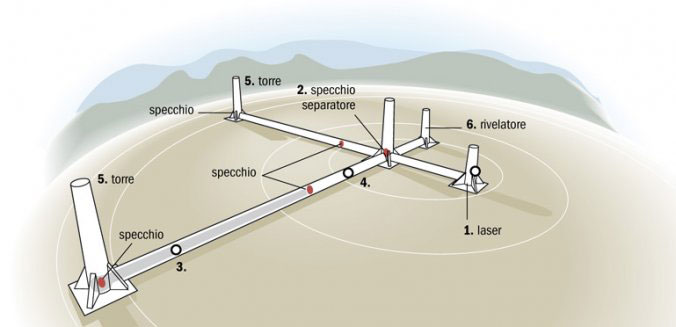
The 14th of September 2015 entered with good reason into the history of science for the first direct observation of a gravitational wave, GW150914, performed by the two LIGO interferometers in the United States. This event, along with the following two observations (GW151226 and GW170104, respectively on the 26th of December 2015 and the 4th of January 2017) was the arrival point of a long and hard research, started by Joseph Weber in the ‘60s, and rightly awarded during the current year with the Nobel Prize in Physics given to Rainer Weiss, Barry C. Barish and Kip S. Thorne.
Inside gravitational interferometers, a laser beam, incident on a semi-transparent mirror, is divided in two beams that propagate in two perpendicular arms, a few kilometers long. These two beams, reflected by some mirrors, after each one has covered its own arm a hundred times, recombine on a light detector, generating an interference figure: an alternating succession of luminous and dark zones. The passage of a gravitational wave through the interferometer causes opposite changes in the length of the arms: one arm stretches, the other one gets shorter. So, the two beams cover paths that are different from the original ones and the interference figure changes. The variation of the length of the arms is very small, smaller than the atomic size. That’s why gravitational waves detection became possible only thanks to the development of highly advanced technologies for laser, suspensions and mirrors.
In August 2017 Virgo, a new interferometer, was added to the American LIGO ones. It’s an interferometer with 3 kilometers-arms, located in Cascina (PI), whose design and initial realization derive from a French-Italian collaboration between CNRS and INFN, which was joined – over the past ten years – by research institutes from other European countries. On the 14th of August 2017 the first joint observation of a gravitational wave, GW170814, by three interferometers was performed. Like the previous events, the wave was produced in the fusion of black holes with a mass on the order of tens of solar masses.

The detection by three laser interferometers finally made it possible to locate the source, which was crucial for the following detection of GW170817, generated by the fusion of two neutron stars in the NGC 4993 galaxy, 130 million light-years away. The report of this discovery appeared on the last 16th of October in the prestigious magazine Physical Review Letters [1]. Actually, in the fusion of two neutron stars, unlike the previous events, it is expected also the emission, more or less delayed, of electromagnetic radiation in a broad wavelength spectrum from γ and X rays to radio waves. Locating the source by the gravitational interferometers in an angular area of about 5 degrees enabled to point 70 telescopes operating on the whole electromagnetic spectrum. They performed the detection of a gamma ray burst and continued to observe the source evolution for several days.
From this first taste of multi-messenger astronomy (the same source analyzed observing different types of radiation) various discoveries came on gravitational waves, gamma ray bursts and cosmic nucleosynthesis. First, comparing the arrival time of the gravitational waves with that of the first gamma rays it turned out that gravitational waves move at the speed of light. Secondly, although we knew about the existence of gamma ray bursts since the ‘60s, only now, for the first time, we could observe their emission in the fusion of two neutron stars. Finally, the study of the electromagnetic radiation emitted in the infrared, visible and ultraviolet band allowed us to prove the production of nuclei of heavy elements, like gold and platinum, in the event (classified as “kilonova” for the total mass involved).
Multi-messenger astronomy, with the detection of gravitational waves, will enable an in-depth study on the phenomena of the violent universe, of which we had just a little knowledge, or maybe to discover further phenomena.
Since last September – and for the next two years – LIGO and Virgo gravitational interferometers will be turned off for the necessary maintenance and upgrade operations aiming at increasing their sensitivity, that is the maximum distance at which a source can be detected (in the past run between 60 and 300 millions of light-years, depending on the interferometer). Since the further we look into space the further we look back in time, that will allow us to observe phenomena increasingly close to the Big Bang.
In the coming years other interferometers will start to operate: KAGRA in Japan (probably in 2018), and LIGO in India. New and more powerful gravitational interferometers are also being developed, to be located in underground laboratories (Einstein telescope) or in space (LISA). More detectors would be beneficial also to keep the detectors network permanently in data taking, since the three interferometers are actually operating for about 50% of time. The minimization of detectors down-time periods would be essential in order to study sources with gravitational waves and neutrinos. Actually, supernovae explosions or fusions of neutron stars are supposed to emit neutrinos too; but those neutrinos, for the weak interaction features, can be abundantly observed only by galactic sources or anyway very close ones, which are expected with at a frequency of some every century.
In this respect, it’s interesting that 2017 marks the 30th anniversary of the observation of the supernovae SN 1987a explosion, in which, for the first and last time until now, along with the light, the emission of neutrinos was measured by three detectors: Kamiokande in Japan, IMB in the United States and Baksan in Russia. (Alessandro Paoloni)
[1] – The paper is freely available at the following link.
Videos:
https://www.ligo.caltech.edu/page/press-release-gw170817
Translation by Camilla Paola Maglione, Communications Office INFN-LNF
 INFN-LNF Laboratori Nazionali di Frascati
INFN-LNF Laboratori Nazionali di Frascati